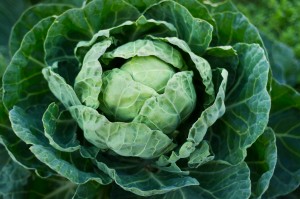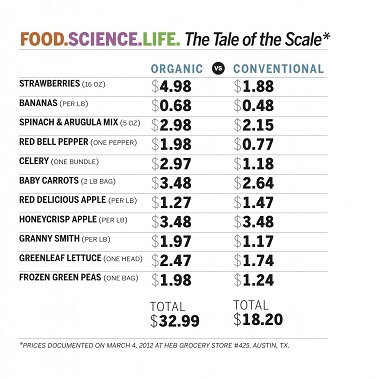A guide to when and how to eat organic, from the college's expert dietitians.
 Should we eat organic fruits and vegetables? It’s a question that often comes up in the courses taught by Monica Meadows, Lydia Steinman and Sara Sweitzer in the Dietetics Program at The University of Texas at Austin.
Should we eat organic fruits and vegetables? It’s a question that often comes up in the courses taught by Monica Meadows, Lydia Steinman and Sara Sweitzer in the Dietetics Program at The University of Texas at Austin.
“If you can afford it,” says Steinman.
“In a perfect world organic is wonderful,” says Sweitzer.
“If you can,” says Meadows.
Meadows, Steinman and Sweitzer consider themselves “soft advocates” of organics. Meadows and Sweitzer say they try to eat organic for some of their diet. Steinman has her own organic garden, consults for an organic baby food company, and helped to launch an organic garden for the studentsat the University of Texas Elementary School in Austin. All three say they believe there’s enough evidence that pesticide residues could be harmful over the long term that it is best to err on the side of feeding organics to young children.
Yet all three say that for most people, organics should be a second-order concern. Far more important is to move toward healthier general nutrition. Equally important for future dietitians is to learn to empathize with the lives of the people whom they’re training to serve.
“Some students come into our program convinced that everyone needs to be eating a vegan, organic, macrobiotic, gluten-free diet,” says Meadows, director of the Coordinated Program in Dietetics at The University of Texas at Austin, which is one of the top-ranked dietetics program in the nation. “But that’s not our job. As dietitians, we don’t tell people that they need to eat a perfect diet. We talk to them about their lives, we listen to them and we work with them to develop recommendations for how to feed themselves and their families in a healthier way. Organics might be a part of that. It might not.”
The good news, say Meadows and her colleagues, is that one doesn’t need to enroll in a dietetics program to begin to make healthier choices. And within that broader program of eating more healthfully, you don’t have to arrive at any final answers on the (very much unsettled) science of organics in order to make good choices about when or whether to buy them. Just adhere to a few basic principles.
Principle One: Eat Your Fruits and Veggies
For most people, the first step on the path to better nutrition is to eat more fruits and vegetables. Period.
“If it’s organic, that’s great,” says Steinman, a distinguished senior lecturer in the Department of Nutritional Sciences in the School of Human Ecology. “But when I’m teaching students, I am far more focused on getting them to eat enough fruits and vegetables than on whether they’re organic or not.”
Meadows says that so few of us are eating enough fruits and veggies that when her dietetic students are first assigned to consult with real clients in their junior year practicum, she’s able to tell them in advance what their initial dietary recommendation should be: Eat more fruits and vegetables.
“Out of a class of 20,” says Meadows, “usually only two or three students will end up with clients who are already eating enough fruits and vegetables.”
It’s only after you’re at the point where you’re eating a healthy amount of fruits and vegetables, she says, that you should worry about buying organic.
Principle Two: Respect Your Budget
“When I was feeding my three teenagers, I didn’t buy much organic because I was filling three stomachs that just inhaled food,” says Sweitzer. “It didn’t fit my food budget.”
 The cost differential between organic and conventional ranges from negligible to considerable.The stark fact is that, for the moment at least, organic fruits and vegetables are more expensive than conventionally grown produce. Sometimes the difference is modest. In season, for instance, the difference between organic and conventionally grown apples can be as little as a few cents per pound. Organic strawberries, on the other hand, can be two to three times as expensive as their conventionally grown counterparts.
The cost differential between organic and conventional ranges from negligible to considerable.The stark fact is that, for the moment at least, organic fruits and vegetables are more expensive than conventionally grown produce. Sometimes the difference is modest. In season, for instance, the difference between organic and conventionally grown apples can be as little as a few cents per pound. Organic strawberries, on the other hand, can be two to three times as expensive as their conventionally grown counterparts.
Rather than feel guilty about not buying organic, says Sweitzer, people should structure their food budgets to maximize the healthy foods they’re buying and integrate organics if it’s manageable to do that without breaking the bank.
“Imagine you’ve got a single mom working two jobs,” says Sweitzer. “She gets home and the choice isn’t typically going to be between a home-cooked dinner made with organic produce and one made with conventionally grown produce. It’s between heating a frozen tray of lasagna or, maybe, making a meal with some fruits and vegetables. Or getting McDonald’s on the way home,” says Meadows.
“There are a lot of barriers to eating healthy,” says Sweitzer. “Time is one of them. Skill is another. You have a lot of people who have very little cooking experience. Money’s one of the biggest ones.”
Principle Three: Look for the Low-Hanging Fruit
Not every conventionally grown fruit and vegetable presents the same risk. The amount of pesticide residue that will actually make it into your mouth varies widely depending on how the fruit or vegetable is grown, how porous its skin is, how effective it is to wash it, and whether it has a peel that you remove before eating.
Meadows, Steinman and Sweitzer say that to get the most bang for your buck spent on organics, you shouldn’t look just at what costs the least. Look also at which fruits and vegetables are known to have the highest levels of pesticide residue when eaten.
To do that, they recommend consulting the “Dirty Dozen” and “Clean 15” lists, which are published every year by the Environmental Working Group (EWG), an environmental nonprofit. The EWG ranks fruits and vegetables based on tests done by the U.S. Department of Agriculture and the federal Food and Drug Administration.
Its Dirty Dozen are those conventionally grown fruits and vegetables that show the highest levels of pesticide residues on them even after they’ve been washed. The Clean 15 are those with the lowest levels.
If you’re looking for a good place to start buying organic, for instance, conventionally grown apples are ranked the “dirtiest” by the EWG. Celery, strawberries and peaches round out the four “dirtiest” conventionally grown fruits and vegetables.
The cleanest four for 2011 were onions, sweet corn, pineapples and avocados. You can eat these, even if they’re not organic, with a clean nutritional conscience.
“In general it’s the ones that you peel before eating that have the lowest pesticide burden,” says Sweitzer.
Principle Four: Put Organics in Context
Ideally, says Steinman, an interest in organic produce is part of a broader orientation toward better nutrition. That’s the model she’s helped to implement at the 20-plot organic garden at UT Elementary, where the students use organic methods but the emphasis is more on understanding how things grow and getting the kids accustomed to vegetables as a natural part of their diet.
“If children are not exposed to fruits and vegetables at a young age,” says Steinman, “it is less likely that they are going to eat them for the rest of their lives.”
For adults too, says Meadows, one good way of viewing organics is as a vehicle for broadening one’s exposure to healthy foods. If fears about pesticide exposure lead you to think more about what you’re putting in your body and to make more informed choices about that, then it’s all to the good. The danger, she says, lies in approaching the issue in isolation.
“I’m a strong advocate for eating a balanced, healthy diet and a soft advocate for making organic the focus of that diet,” she says. “I’d hate for people to avoid buying an apple because it’s not an organic apple. That would be taking what could be good nutritional information too far. An apple is not poison.”


















Comments